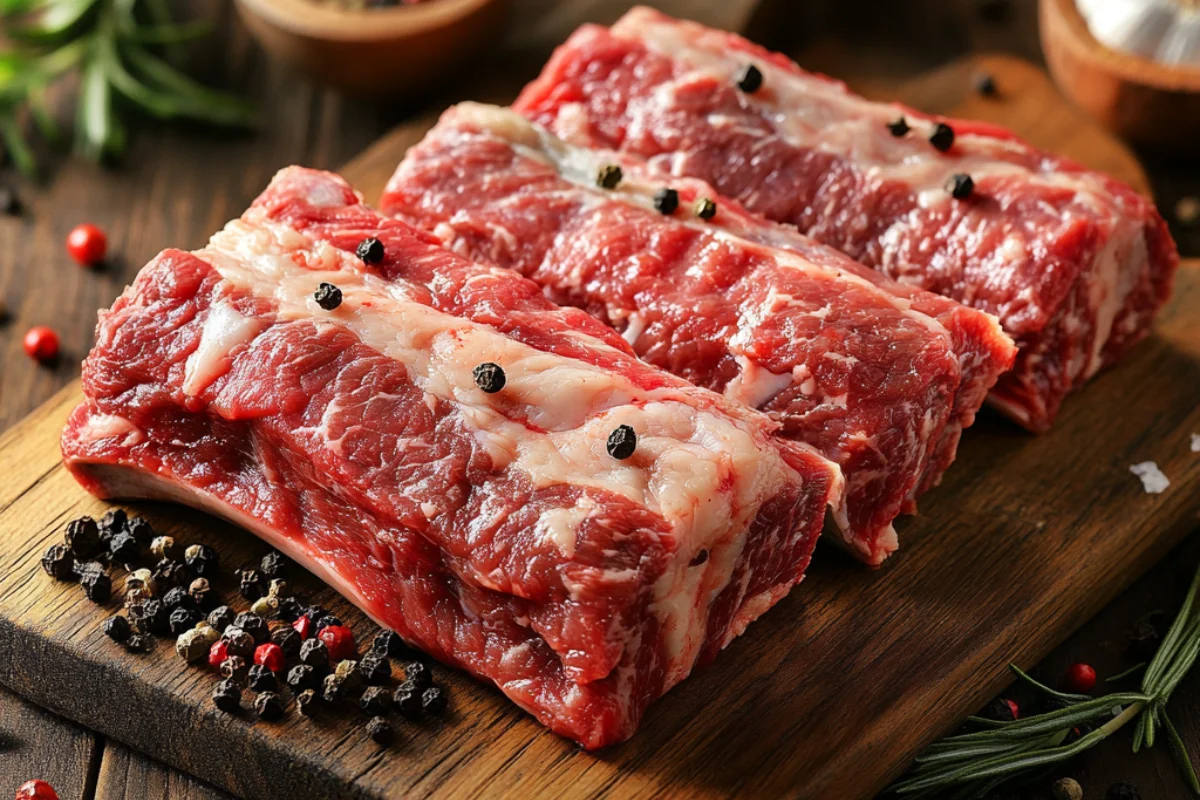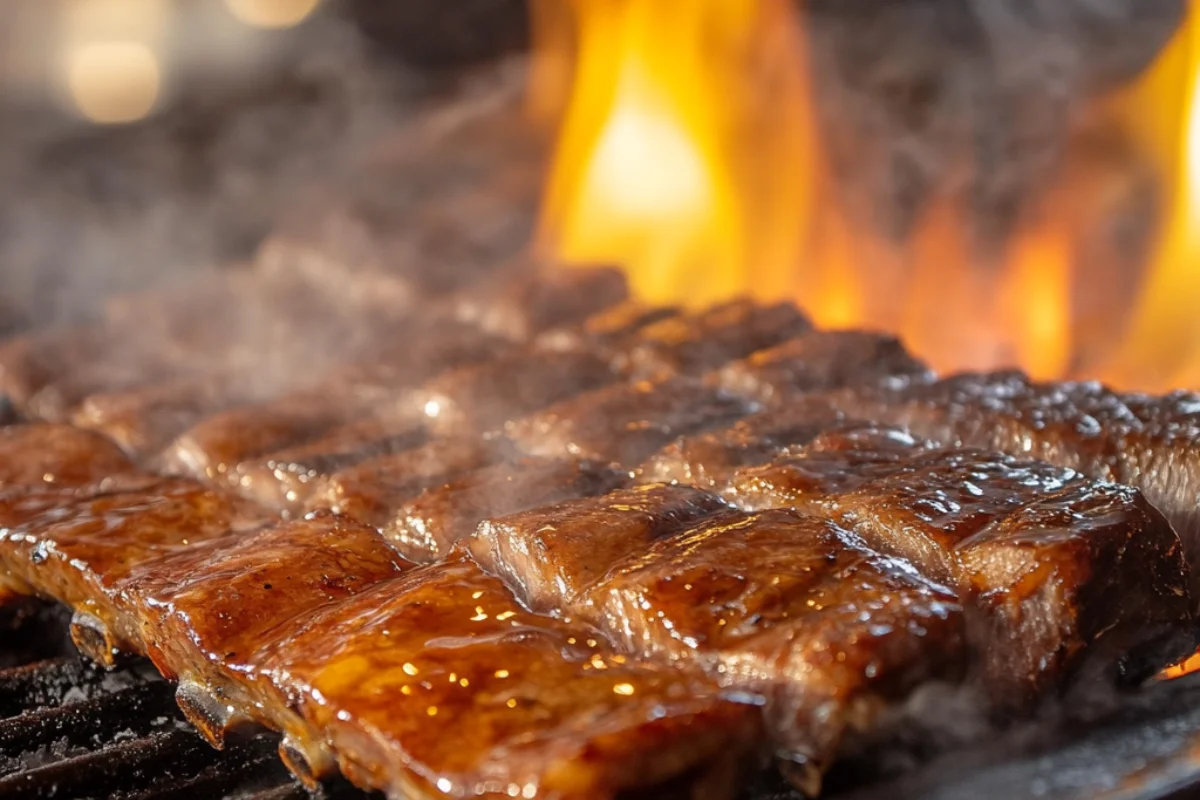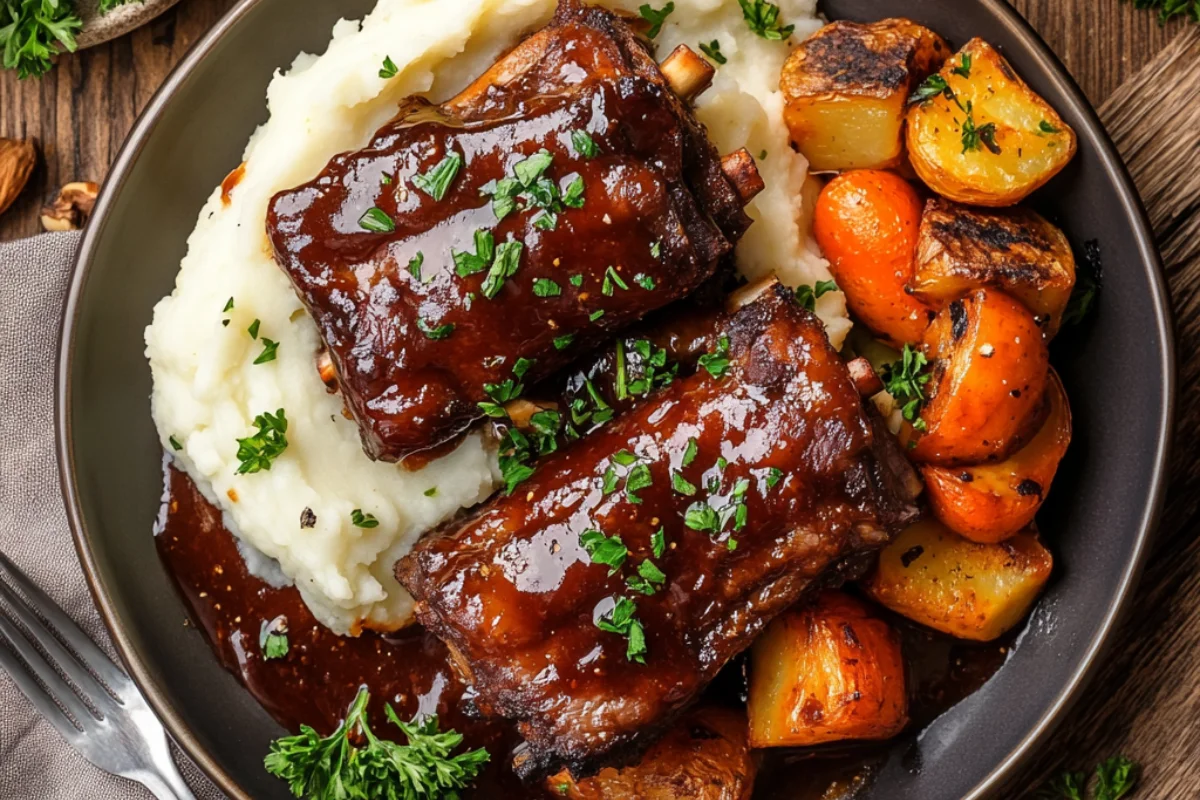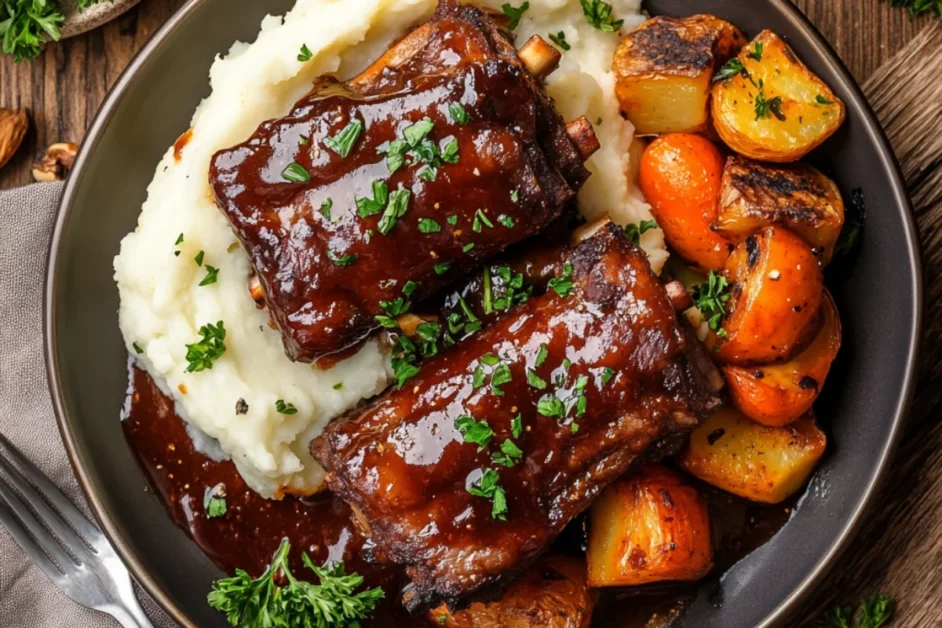Boneless beef ribs are a delicious, tender, and versatile cut of meat that can be cooked in various ways, from grilling to slow-cooking. They provide a rich, meaty flavor without the hassle of dealing with bones, making them a convenient option for home cooks. Whether you’re preparing a weeknight dinner or a special barbecue feast, boneless beef ribs offer an easy and satisfying way to enjoy a hearty meal.
What Are Boneless Beef Ribs?
Boneless beef ribs are not technically ribs, despite their name. They are usually cut from different sections of the cow, such as:
- Chuck (Chuck Ribs or Country-Style Ribs): These come from the shoulder area and have a great balance of meat and fat, making them ideal for slow-cooking or braising.
- Short Rib Cut (Plate Ribs): This cut comes from the lower rib cage and has deep marbling, offering a rich beefy taste.
- Ribeye Cap (Boneless Beef Back Ribs): These ribs come from the area near the ribeye, providing a tender and flavorful option.
Boneless beef ribs are an excellent alternative to traditional bone-in ribs because they offer the same taste and texture but with more meat per serving. They are also easier to eat since there’s no need to work around bones.
Why Choose Boneless Beef Ribs Over Bone-In?
Boneless beef ribs have several advantages over their bone-in counterparts:
Pros of Boneless Beef Ribs
- More meat, less waste: Since there are no bones, you get more beef per pound.
- Easier to prepare: Boneless ribs can be marinated and cooked more evenly.
- Quick cooking options: They can be grilled, seared, or baked faster than bone-in ribs.
- Convenience: No need to cut around the bones, making them easier to eat.
Cons of Boneless Beef Ribs
- Slightly less flavor: The bone adds extra depth to the meat’s flavor, which boneless ribs lack.
- Can dry out faster: Without the bone, boneless ribs can lose moisture more easily if not cooked properly.
Despite these minor drawbacks, boneless beef ribs are still a fantastic choice for anyone looking for a meaty and flavorful dish with minimal hassle.
Different Cooking Methods for Boneless Beef Ribs
Boneless beef ribs can be cooked in multiple ways, depending on the texture and flavor you prefer. Here are some of the most popular cooking methods:
1. Grilling
- Best for: A smoky, charred exterior with a juicy inside.
- How to do it: Marinate the ribs, then grill over medium-high heat for about 5–7 minutes per side.
- Pro tip: Use indirect heat after searing to ensure they cook evenly without drying out.
2. Slow-Cooking
- Best for: Fall-apart tenderness with deep flavors.
- How to do it: Cook in a slow cooker with broth, barbecue sauce, or seasoning for 6–8 hours on low.
- Pro tip: Browning the ribs before slow-cooking enhances the flavor.
3. Baking
- Best for: Oven-roasted ribs with a slightly crispy exterior.
- How to do it: Bake at 300°F for 2–3 hours, covered with foil to retain moisture.
- Pro tip: Baste with sauce during the last 30 minutes for a caramelized finish.
4. Pressure-Cooking (Instant Pot)
- Best for: A quick way to achieve tenderness.
- How to do it: Cook on high pressure for 40–45 minutes, followed by a natural release.
- Pro tip: Finish with a quick broil for extra crispiness.
Each method brings out different textures and flavors, allowing you to customize your ribs based on your preference.
Selecting the Best Boneless Beef Ribs
When choosing boneless beef ribs, consider these factors:
- Marbling: Look for well-marbled meat with streaks of fat, which add juiciness and flavor.
- Cut thickness: Choose ribs that are at least 1-inch thick to prevent them from drying out during cooking.
- Color: Fresh beef should be bright red, not brown or gray.
- Smell: High-quality beef should have a mild, fresh smell—avoid anything with a sour or strong odor.
Grass-Fed vs. Grain-Fed Beef Ribs
- Grass-Fed Beef: Leaner, with a slightly stronger beefy flavor. Best for those looking for a healthier option.
- Grain-Fed Beef: More marbled, offering a richer taste and more tender texture.
Fresh vs. Frozen Boneless Beef Ribs
- Fresh Ribs: Offer the best flavor and texture.
- Frozen Ribs: Can be just as good if properly thawed. Thaw in the refrigerator overnight to maintain quality.
Essential Ingredients for the Perfect Beef Ribs
The right spices and seasonings elevate boneless beef ribs to the next level. Whether you prefer a dry rub or a flavorful marinade, here’s what you need:
Must-Have Spices & Seasonings
- Paprika: Adds a smoky, slightly sweet flavor.
- Garlic Powder & Onion Powder: Enhance the savory taste.
- Black Pepper & Salt: Essential for seasoning.
- Brown Sugar: Balances the spices with a touch of sweetness.
- Cayenne Pepper or Chili Powder: Adds heat for a spicy kick.
Marinades and Dry Rubs
- Dry Rubs: A blend of spices that creates a flavorful crust when cooked. Best for grilling and baking.
- Marinades: A liquid-based seasoning (soy sauce, Worcestershire, or citrus juice) that helps tenderize and infuse flavor.
Both methods work well, and you can experiment to find your favorite combination.
How to Cook Boneless Beef Ribs – Step-by-Step Guide
Boneless beef ribs are a delicious, versatile cut that can be cooked in various ways to achieve the perfect balance of tenderness and flavor. Whether you prefer baking, grilling, slow-cooking, or pressure-cooking, this guide will walk you through every step to ensure your ribs turn out juicy and flavorful every time.
Preparing the Ribs for Cooking

Before you start cooking, proper preparation is key to enhancing the flavor and texture of boneless beef ribs.
1. Trimming Excess Fat
- While some fat is essential for flavor, too much can lead to excessive greasiness.
- Use a sharp knife to trim off any thick, hard fat layers without removing too much of the marbling.
- Leave a thin layer of fat to keep the ribs juicy.
2. Seasoning the Ribs
- Seasoning is what makes the difference between good and great ribs.
- You can choose between a dry rub or a marinade depending on your preferred cooking method.
Dry Rub (for a rich, caramelized crust)
- Basic Ingredients: Salt, black pepper, paprika, garlic powder, onion powder, brown sugar, cayenne pepper.
- How to Apply: Pat the ribs dry, then rub the seasoning generously all over.
- Resting Time: Let them sit for at least 30 minutes (or overnight for deeper flavor).
Marinade (for extra tenderness and infusion of flavor)
- Common Marinade Base: Soy sauce, Worcestershire sauce, olive oil, vinegar, and seasonings.
- Marinating Time: 2–12 hours in the refrigerator for the best results.
Cooking Boneless Beef Ribs in the Oven
Oven-baked boneless beef ribs are an excellent way to achieve juicy, tender meat with minimal effort.
Step-by-Step Baking Guide
- Preheat the Oven: Set it to 300°F (150°C) for slow-roasting or 400°F (200°C) for quicker cooking.
- Prepare the Ribs: Place them in a roasting pan or baking sheet lined with foil.
- Add Moisture: To prevent drying out, add ½ cup of broth or water to the pan and cover the ribs with foil.
- Baking Time:
- Low & Slow (Best for tenderness): Bake at 275°F for 2.5–3 hours.
- High Heat (For a faster result): Bake at 400°F for 45 minutes to 1 hour, flipping halfway.
- Caramelization Step: In the last 10 minutes, remove the foil, brush with BBQ sauce, and broil for a crispy glaze.
Low and Slow vs. High Heat Cooking
| Method | Temperature | Time | Result |
|---|---|---|---|
| Low & Slow | 275°F (135°C) | 2.5–3 hrs | Tender, fall-apart texture |
| High Heat | 400°F (200°C) | 45–60 min | Slightly firmer, caramelized crust |
For maximum tenderness, low and slow cooking is preferred.
Grilling Boneless Beef Ribs for Smoky Flavor

Grilling is perfect for adding a rich, smoky flavor to your ribs. Follow these steps for perfectly grilled boneless beef ribs:
Step-by-Step Grilling Guide
- Preheat the Grill: Set it to medium-high heat (350–400°F).
- Oil the Grill Grates: Prevent sticking by brushing with oil.
- Sear the Ribs: Grill over direct heat for 4–5 minutes per side to get a good crust.
- Move to Indirect Heat: Cook for another 15–20 minutes, flipping occasionally.
- Baste with BBQ Sauce: In the last 5 minutes, brush with sauce for a caramelized finish.
- Rest Before Serving: Let the ribs rest for 5–10 minutes to allow juices to redistribute.
Pro Tip: Use wood chips (like hickory or mesquite) in a smoker box for an even deeper smoky flavor.
Slow Cooker Boneless Beef Ribs
For the most tender, fall-apart ribs, the slow cooker is your best friend.
Step-by-Step Slow Cooker Guide
- Sear the Ribs (Optional): Brown them in a hot pan for extra flavor.
- Layer in the Slow Cooker: Place ribs at the bottom and cover with sauce or broth.
- Add Seasoning: Garlic, onions, and herbs can enhance flavor.
- Set the Cooking Time:
- Low Heat: 7–8 hours for maximum tenderness.
- High Heat: 4–5 hours if you’re short on time.
- Final Step: Brush with BBQ sauce and broil for 5 minutes for a crispy exterior.
Best Slow Cooker Settings & Cooking Time
| Setting | Time | Result |
|---|---|---|
| Low Heat | 7–8 hrs | Super tender, fall-apart meat |
| High Heat | 4–5 hrs | Slightly firmer, but still juicy |
Instant Pot or Pressure Cooker Boneless Beef Ribs
If you’re short on time, a pressure cooker can make ribs tender in under an hour.
Step-by-Step Pressure Cooker Guide
- Sear the Ribs: Use the sauté function to brown them.
- Add Liquid: Use 1 cup of beef broth or BBQ sauce.
- Set Cooking Time: Cook on high pressure for 40–45 minutes.
- Natural Release: Let pressure release naturally for 10–15 minutes.
- Finish in the Oven (Optional): Broil for a crispy crust.
Pressure Cooking vs. Slow Cooking
| Method | Time | Texture & Flavor |
|---|---|---|
| Pressure Cooker | 40–45 min | Tender, but slightly less developed flavor |
| Slow Cooker | 7–8 hrs | Maximum depth of flavor, fall-apart meat |
Pro Tip: If using a pressure cooker, always deglaze the pot after searing to prevent burning.
Searing vs. Braising Boneless Beef Ribs
Both searing and braising are techniques that add depth and richness to boneless beef ribs.
Searing (For Crust & Caramelization)
- Searing locks in juices and creates a flavorful crust.
- Best when followed by slow cooking or baking.
- Heat a pan to high, add oil, and sear for 2–3 minutes per side.
Braising (For Extra Tenderness)
- Cooking ribs in liquid at low heat for a long time helps break down tough fibers.
- Best for oven or slow cooker recipes.
- Use broth, wine, or a marinade for extra depth.
Pro Tip: Sear first, then braise for the best of both worlds—flavorful crust and ultra-tender meat.
Boneless beef ribs are incredibly versatile and can be cooked using multiple methods, from slow-cooking for tenderness to grilling for a smoky char. Whether you’re looking for a quick meal or a slow-cooked delicacy, this guide ensures your ribs turn out juicy, flavorful, and absolutely delicious.
How to Serve Boneless Beef Ribs Like a Pro

Boneless beef ribs are a flavorful and hearty dish that can be elevated with the right plating, sides, and presentation techniques. Whether serving them for a family dinner or a special gathering, here are some expert tips to make your meal restaurant-worthy:
- Slicing for Presentation – Slice the ribs against the grain into bite-sized pieces for easy eating and a tender bite.
- Plating on a Wooden Board – A rustic wooden board or cast iron skillet enhances the visual appeal.
- Drizzling with Sauce – Brushing ribs with a glossy glaze or sauce right before serving makes them look irresistible.
- Garnishing with Fresh Herbs – Sprinkle fresh parsley, chives, or cilantro for a pop of color and freshness.
- Pairing with Complementary Sides – Serve with a well-balanced selection of side dishes to complement the rich flavors.
Best Side Dishes for Boneless Beef Ribs
Boneless beef ribs pair perfectly with both classic comfort foods and lighter sides. Here are some of the best side dishes to serve:
Classic Side Dishes
- Mashed Potatoes – Buttery and creamy, they balance the richness of the ribs.
- Roasted Vegetables – Carrots, Brussels sprouts, and asparagus add texture and nutrition.
- Mac & Cheese – A creamy, cheesy delight that pairs beautifully with smoky ribs.
- Coleslaw – A tangy, crunchy contrast to the soft, tender meat.
- Cornbread – Sweet and savory, cornbread is a Southern staple with BBQ ribs.
Lighter & Healthier Sides
- Grilled Asparagus – A slightly charred, fresh addition.
- Steamed Broccoli – A simple yet healthy complement.
- Quinoa Salad – A high-protein alternative to heavier starches.
- Cucumber & Tomato Salad – A fresh, crisp side that cleanses the palate.
- Cauliflower Rice – A low-carb alternative to traditional grains.
Pro Tip: Pairing ribs with a balance of carbs, vegetables, and fresh flavors enhances the overall meal.
Sauces and Glazes for Extra Flavor
The right sauce or glaze can take your boneless beef ribs to the next level. Here are some popular options:
Classic Sauces
- BBQ Sauce – The go-to choice for sweet, smoky ribs.
- Honey Bourbon Glaze – A rich, caramelized flavor with a hint of whiskey.
- Garlic Butter Sauce – Simple yet luxurious, perfect for oven-baked ribs.
International Twists
- Korean Gochujang Sauce – A sweet and spicy kick.
- Mexican Adobo Sauce – Smoky, earthy flavors with chili peppers.
- Teriyaki Glaze – A sweet and savory Asian-inspired choice.
Pro Tip: Glaze the ribs during the last 10 minutes of cooking to create a beautiful caramelized finish.
Leftover Boneless Beef Ribs – Storage & Reheating Tips
Boneless beef ribs taste amazing the next day if stored and reheated properly. Here’s how to keep them moist and flavorful:
Refrigeration vs. Freezing Leftovers
| Storage Method | How Long It Lasts | Best Storage Tips |
|---|---|---|
| Refrigerator | 3–4 days | Store in an airtight container. |
| Freezer | Up to 3 months | Wrap in foil, then place in a freezer bag. |
Pro Tip: Store ribs with a bit of their sauce or juices to keep them moist.
Best Methods to Reheat Without Losing Flavor
- Oven (Best for Even Heating)
- Preheat to 300°F.
- Wrap ribs in foil with a splash of broth or sauce.
- Heat for 15–20 minutes until warm.
- Skillet (Quick & Crispy Edges)
- Heat a pan over medium heat.
- Add a little oil or butter.
- Sear each side for 2–3 minutes.
- Microwave (Fastest Option)
- Place ribs in a microwave-safe dish.
- Cover with a damp paper towel.
- Heat in 30-second intervals to prevent drying.
Pro Tip: Avoid overheating in the microwave to maintain tenderness.
Variations – Unique Twists on Boneless Beef Ribs
Boneless beef ribs can be adapted to different cuisines for a creative, flavorful twist.
Asian-Style Boneless Beef Ribs
- Marinade: Soy sauce, sesame oil, ginger, and honey.
- Cooking Method: Grill or bake, then top with sesame seeds and green onions.
- Pairing: Serve with steamed rice and stir-fried vegetables.
Mexican-Inspired Boneless Beef Ribs
- Marinade: Lime juice, chipotle, garlic, and cumin.
- Cooking Method: Slow cook until tender, then shred for tacos or burritos.
- Pairing: Serve with tortillas, guacamole, and salsa.
Smoky Texas BBQ Ribs
- Dry Rub: Paprika, cayenne, brown sugar, and garlic powder.
- Cooking Method: Slow-smoked or oven-baked for deep BBQ flavors.
- Pairing: Cornbread and coleslaw.
Keto & Low-Carb Beef Ribs
For a low-carb version, avoid sugar-heavy sauces. Instead:
- Use a sugar-free BBQ sauce or make your own with tomato paste, vinegar, and spices.
- Swap brown sugar for erythritol or monk fruit sweetener in rubs.
- Pair with keto-friendly sides like roasted cauliflower or sautéed greens.
Spicy vs. Sweet Ribs
You can easily adjust the seasoning to match your taste:
- For Spicy Ribs: Add extra cayenne, chili powder, or hot sauce.
- For Sweet Ribs: Use honey, brown sugar, or maple syrup for caramelization.
Frequently Asked Questions (FAQs)
1. How long should I marinate boneless beef ribs?
For the best flavor, marinate for at least 2 hours, but overnight is ideal.
2. What’s the best way to make ribs more tender?
Use low and slow cooking methods like baking at 275°F or slow-cooking for 7–8 hours.
3. Can I cook boneless beef ribs from frozen?
Yes, but they will take longer to cook. For best results, thaw them in the refrigerator overnight.
4. What’s the difference between boneless beef ribs and short ribs?
Boneless beef ribs come from the chuck or ribeye cap, while short ribs come from the lower rib section and have more connective tissue.
5. Should I sear ribs before slow cooking?
Yes, searing locks in juices and adds flavor. It’s an extra step that makes a big difference.

